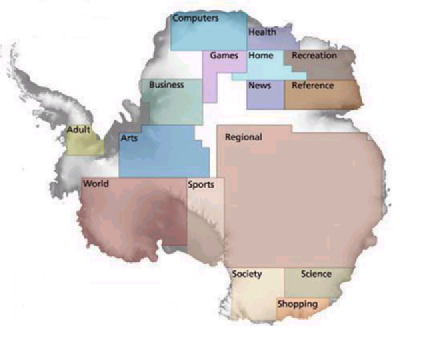I’ve been telling my kids they’d better study their math and English, because there won’t be any jobs available for video-game players when they grow up. Now I’m not so sure that’s true.
The Web site that caused this doubt is map.net, a project of Antarcti.ca Systems Inc., of Vancouver, British Columbia. The man behind Antarcti.ca is Tim Bray, one of the inventors of XML. Map.net uses a game-like interface to provide a 3-D view of the entire World Wide Web. Antarcti.ca Systems developed map.net with its Visual Net product, which allows people to design visual representations of networks for ease of administration. To see what I’m talking about, point your browser to map.net and antarcti.ca (no www is needed in either URL).
Figure 1 shows how you’ll be greeted. The Web is mapped to the continent of Antarctica, which is divided into regions of interests. Imagine yourself hovering over Antarctica in a flying saucer. To descend for a closer look, move the mouse pointer to a particular region and click. As the crew of a flying saucer would begin to discern buildings, rivers, trees, and other landmarks as they drew closer to the ground (that is, if Antarctica had any), Web surfers will begin to see links to Web sites. Surfers won’t see the contents of the Web sites, of course, just as the crew of the saucer would not see the contents and inhabitants of buildings.
Each Web site is represented by a red circle. The larger the circle, the more pages the Web site contains. The red circle may be surrounded by a white ring, the size of which indicates the popularity of the site. A black ring around a circle means the site is well- connected to other sites. Four yellow arrowheads around a circle indicate a “cool” Web site. A Web site’s name sits beside its circle. The name gets larger when you move the mouse pointer over it, and you can enter a site by clicking on its name.
I’ll leave the rest to you. You can take the virtual tour, get involved in the chat rooms, surf the Web in Hindi, or whatever else you find to do there. I’m curious to hear your impressions of map.net.
It’s Not Whether You Win or Lose
Map.net is a good reminder that the Web, and the Internet as a whole, is constantly changing. In five years, the Internet will not look the way it does today. It is doubtful the Web will look like map.net, because map.net is only a first effort. But the idea that the Web will be navigated in a more graphical manner is not far-fetched, especially if you consider
that commercial software is moving in that direction. For example, consider the graphical map of a query plan shown in Visual Explain, which I mentioned in an earlier issue (“Tools You Didn’t Know You Can’t Live Without,” MC, August 2000). However, for developers of application software, map.net offers other lessons.
First, the definition of text-based is changing. Over the past few years, I have read time and again that text-based computer interfaces are passé. In this context, text-based means green-screen. A Web browser that is displaying a list of Web sites is graphical, not text-based. However, compared with the fly-over interface of map.net, a search engine is text-based. That is, a search engine displays a list of textual descriptions, whereas map.net provides graphical descriptions. Just think, someday the way Web sites currently look may be as antiquated as the MSDOS C:> prompt.
Second, map.net supports the idea that alternate interfaces are needed for the same data. Within a short time of surfing map.net, I found a useful Web site I had never found before while using various search engines. Users are not alike in their abilities or in the way they see the world. Alternate views of the same reality may be helpful even in organizations of only a few people.
Third, many iSeries- and AS/400-based shops wrestle with the decision of whether to migrate interactive programs to GUI or to CGI. Map.net suggests that the appropriate interface may be a game interface. (Although I am having difficulty imagining a user asking how to use a joystick to navigate Accounts Receivable, it’s not inconceivable.)
It’s How You Play the Game
All this brings me back to where I started. A game-like interface, such as that of map.net, may be the Web counterpart to the membrane interface of cash registers in fast-food restaurants. Replacing keys with a membrane reduced the number of errors that employees made. Who knows? Replacing the green-screen with a game-like interface might do the same for some of your users.
Figure 1: Map.net treats Web sites as if they were geographical locations.


















 Business users want new applications now. Market and regulatory pressures require faster application updates and delivery into production. Your IBM i developers may be approaching retirement, and you see no sure way to fill their positions with experienced developers. In addition, you may be caught between maintaining your existing applications and the uncertainty of moving to something new.
Business users want new applications now. Market and regulatory pressures require faster application updates and delivery into production. Your IBM i developers may be approaching retirement, and you see no sure way to fill their positions with experienced developers. In addition, you may be caught between maintaining your existing applications and the uncertainty of moving to something new. IT managers hoping to find new IBM i talent are discovering that the pool of experienced RPG programmers and operators or administrators with intimate knowledge of the operating system and the applications that run on it is small. This begs the question: How will you manage the platform that supports such a big part of your business? This guide offers strategies and software suggestions to help you plan IT staffing and resources and smooth the transition after your AS/400 talent retires. Read on to learn:
IT managers hoping to find new IBM i talent are discovering that the pool of experienced RPG programmers and operators or administrators with intimate knowledge of the operating system and the applications that run on it is small. This begs the question: How will you manage the platform that supports such a big part of your business? This guide offers strategies and software suggestions to help you plan IT staffing and resources and smooth the transition after your AS/400 talent retires. Read on to learn:
LATEST COMMENTS
MC Press Online